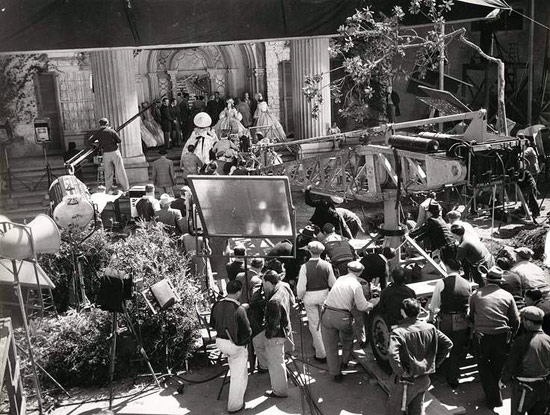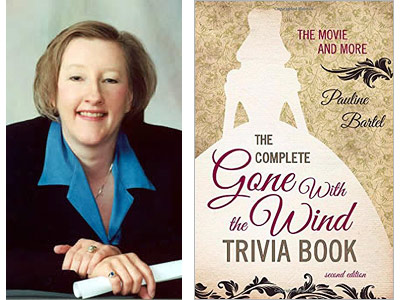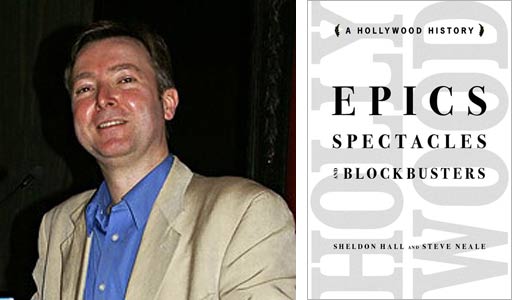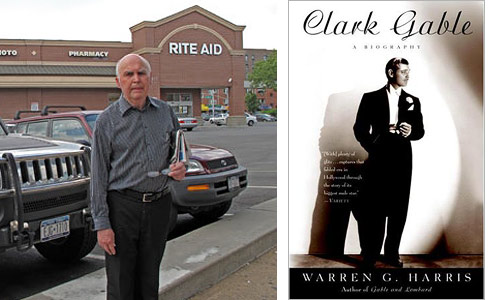[Editor’s Note: This article was intended to appear a year ago for the film’s 75th anniversary. Following a series of delays and cancellations, it’s being published now for the film’s 76th anniversary. And if you’re upset about the delay, well, frankly, my dear readers, I don’t give a damn.]
“Never in our lifetime have eyes beheld its equal”
The Digital Bits is pleased to present this retrospective article commemorating the 75th anniversary of the release of Gone With the Wind, David O. Selznick’s acclaimed motion picture adaptation of Margaret Mitchell’s best-selling novel of the Old South and which starred Clark Gable as Rhett Butler and Vivian Leigh as Scarlett O’Hara. [Read on here...]
The all-time box-office champion, directed by Victor Fleming, also starred Leslie Howard, Olivia de Havilland and Hattie McDaniel. The recipient of ten Academy Awards, Gone With the Wind was the industry’s top-earning motion picture for an unprecedented 26 years. (Variety listed it the all-time box-office champion during the reporting periods of 1940-1960, 1962-1966, and 1971-1972.) Adjusted for inflation, the film remains the number one box-office attraction of all time.
The Bits celebrates the famous film with a detailed chronology of its original theatrical roadshow engagements and an interview segment with a group of film historians and Gone With the Wind enthusiasts who discuss the its popularity and legacy.
PART 1: THE Q&A
This segment of the article features an interview with an esteemed group of film historians and authors. The interviews were conducted separately and have been edited into a “roundtable” format.
Pauline Bartel is the author of The Complete Gone With the Wind Trivia Book (Taylor, 1989; revised edition 2014).
Sheldon Hall is the author (with Steve Neale) of Epics, Spectacles, and Blockbusters: A Hollywood History (Wayne State University Press, 2010).
Warren G. Harris is the author of Clark Gable: A Biography (Harmony, 2002).
Kim R. Holston is the author of Movie Roadshows: A History and Filmography of Reserved-Seat Limited Showings, 1911-1973 (McFarland, 2013).
Steve Wilson is the author of The Making of Gone With the Wind (University of Texas, 2014) and the curator of the 2014-15 Gone With the Wind exhibit at the Harry Ransom Center at the University of Texas.
---
Michael Coate (The Digital Bits): In what way is Gone With the Wind worthy of celebration on its 75th anniversary?
Pauline Bartel: Gone With the Wind’s 75th anniversary was worthy of celebration because this Academy-Award-winning, box-office champion remains one of the most popular, best-loved movies in history. Gone With the Wind debuted during a year that film critics and historians consider Hollywood’s Golden Year. Among the other films released in 1939 and nominated for Best Picture by the Academy of Motion Picture Arts and Sciences were Dark Victory; Goodbye, Mr. Chips; Love Affair; Mr. Smith Goes to Washington; Ninotchka; Of Mice and Men; Stagecoach; The Wizard of Oz; and Wuthering Heights. Among this resplendent field, only Gone With the Wind earned an unprecedented 13 Academy Award nominations in 12 categories, including a double nomination for Best Supporting Actress, and won a record-breaking 8 competitive Academy Awards. That record stood for two decades, until 1959’s Ben-Hur earned 11 Academy Awards…. Gone With the Wind remains a winner at the box office. The film holds its #1 spot on the list of all-time movie moneymakers with $1.64 billion in adjusted gross income. The film is also ranked #1 on the list of all-time ticket sales with more than 202 million tickets sold in North America. For 75 years Gone With the Wind has been a cinematic and popular culture juggernaut, which makes the film worthy of recognition and celebration.
 Sheldon Hall: Aside from its enormous popularity, Gone With the Wind is often regarded as an exemplary product of the “classical” studio system of the time in which it was made—even though it is technically an independent production. The craft skills associated with the Golden Age of Hollywood are spectacularly well displayed in every department. It is also historically significant for its representation of race and slavery, a matter about which many observers nowadays feel distinctly and understandably uncomfortable, while others appear sanguine.
Sheldon Hall: Aside from its enormous popularity, Gone With the Wind is often regarded as an exemplary product of the “classical” studio system of the time in which it was made—even though it is technically an independent production. The craft skills associated with the Golden Age of Hollywood are spectacularly well displayed in every department. It is also historically significant for its representation of race and slavery, a matter about which many observers nowadays feel distinctly and understandably uncomfortable, while others appear sanguine.
Warren G. Harris: The 75th anniversary of 1939, often cited as the greatest year in Hollywood history, is really the celebrant here, and Gone With the Wind won the industry’s Oscar for best picture of that year.
Kim R. Holston: In that most glorious year of Hollywood films, the scope and length and stars of Gone With the Wind raised it to the pinnacle. It proved that a relative newcomer (Vivien Leigh) could be found to make the part her own. It showed Clark Gable at the top of his game. (World War II service would soon keep him off the screen and most of his post-war movies are less than sterling, memorable only by his presence.) And let’s not forget Max Steiner’s score.
Steve Wilson: During our exhibition last year and in the book, The Making of Gone With the Wind, we tried to be careful about using the word “celebrate.” For many people, Gone With the Wind is the epitome of racism in America, so we tried to be sensitive to that and made an effort to examine how the film came to be the way it is. The novel, of course, is much more problematic in terms of racism. David O. Selznick, the producer of the film, recognized this early on, and in preliminary discussions with Sidney Howard, the screenwriter, decided to try to mitigate some of the problems. For example, Selznick and Howard decided from the beginning to eliminate any mention of the Ku Klux Klan. They also decided to avoid having any of the African-American characters do anything immoral or illegal in the film. Later, Selznick was contacted by Walter White, director of the NAACP, who was concerned, based on what he had read in the novel, about the depiction of African Americans in the film. While White’s concerns did little to change the script or the direction of the film (Howard had finished his draft by this time), I believe the discussion sensitized Selznick to the issues, to the point when, a few months later, when Earl Morris of the Pittsburgh Courier, an African-American newspaper, wrote a series of blistering editorials focusing on the screenplay’s inclusion of the word “nigger,” Selznick did some soul searching. In a memo to his business partner, Jock Whitney, Selznick spoke of his being Jewish at a time when Jews were under attack in Europe and consequently feeling some understanding of the minority point of view. In short order, as a direct result of Morris’s editorials and correspondence with Morris, Selznick eliminated the offensive word from the film. Had the word remained in the film, I believe we would be so offended and embarrassed by the film that we would not be talking about it today…. There are still problems with the film, of course. The depiction of African-American slaves being happy with their lot in life is offensive to many. I have been told by scholars, however, that the depiction of slavery in the film is in line with what everyday people understood about slavery in 1939. Much of the slave narratives gathered by the Federal Writer’s Project during the Great Depression had not yet made their way to the general public. Furthermore, while most African-American newspapers panned the film in their reviews, praise for the performances of the African-American actors, Hattie McDaniel in particular, was widespread. By the time Gone With the Wind played in African-American theaters, McDaniel had won the Academy Award and was the object of great pride in the African American community…. So the story of Gone With the Wind is much more complicated and nuanced than many people today realize. It is as messy and problematic as American history itself. So while I would hesitate to “celebrate” the 75th anniversary of the film, I’m very glad that it is still part of our culture because it gives us an opportunity to discuss issues that are still, to this day, important to us all.

Coate: Why is Gone With the Wind frequently cited as the most popular film ever made?
Bartel: Gone With the Wind is a story of survival, and its message that “tomorrow is another day” resonates with people needing hope that tomorrow will be better than today. This message spoke to moviegoers in the Depression and World War II years; the message speaks to viewers today who see the world spinning out of control from financial crises, terrorism and endless wars. In Gone With the Wind, Scarlett does whatever it takes to keep her home, feed her family and survive hard times. Those struggles are universal. Gone With the Wind shows viewers that if they are brave and determined, if they let nothing stand in their way—like Scarlett—they can survive.
Hall: On its first release, Gone With the Wind grossed considerably more than any other film yet made (though it was for many years speculated that The Birth of a Nation had grossed more, for which there was no reliable evidence). It continued to earn significant money on numerous subsequent reissues, maintaining its position near the top of the unadjusted box-office charts for several decades. Although it has since been surpassed in basic monetary terms, adjustment of figures for inflation suggests that in real terms (estimated theatrical ticket sales) it is far ahead of any other film ever made. Quite aside from this benchmark commercial performance, Gone With the Wind remains popular in the other sense of that word: it is well-liked and well-remembered by vast numbers of people. This sheer, continuing revivability over many years surely testifies to its status as the “people’s choice” of old movies. (That does not, of course, make it the best!)
Harris: Popularity of the movie is tied to that of the novel, which is still widely read today. Characters of Scarlett and Rhett have become part of American folklore, and are still relevant today.
Holston: It could be the most popular film ever. It held the top spot until The Sound of Music came along in 1965 and Sound of Music’s grosses need to be adjusted based on inflation.
Coate: Can you recall your reaction to the first time you saw Gone With the Wind?
Bartel: I was blown away by the Wind at the age of 16 when, during Christmas vacation from school, I accompanied my mother to see the film’s latest reissue. I identified with Scarlett’s love for Ashley, as only a teenager suffering the pangs of unrequited love could. I struggled with Scarlett through the destruction of the Civil War and the devastation of Reconstruction. I put on the green velvet drapery dress and went to Atlanta with Scarlett to try to get tax money from a jailed Rhett. I was with her when she was attacked at Shantytown, when she was caught in Ashley’s arms, and when Bonnie was thrown from her pony. By the end of the movie, I was in tears and in love with this spectacular story of indomitable will and indestructible spirit.
Hall: My first viewing of Gone With the Wind was on British television at Christmas 1981, its UK TV premiere. Because of the film’s length it was split over two evenings, much to the distaste of the press. I watched it and remember that I enjoyed it, but not much more than that. I have a stronger memory of its second British TV screening, in October 1983, when I had just started university as an undergraduate student. At the time comparatively few students had televisions in their university accommodation, but there was a large TV lounge in the Student Union building. Gone With the Wind was this time shown in its entirety on a Sunday evening and I went to the TV lounge to catch the latter part of the film. The room was absolutely packed, with rows of students standing at the back. Despite its age (44 years at the time), its fame clearly still extended to younger generations.
Harris: My mother was a Gone With the Wind fanatic, so I knew much about the book and movie as a child, but didn’t actually see the film until the first wide-screen reissue in 1954. I loved it, but had serious reservations about the image cropping that resulted.
Holston: I couldn’t wait to see it during its grand 1967 restoration. It was a roadshow again and I traveled into Philadelphia to see it at the Randolph Theater. (That morning I saw Bonnie and Clyde at the Goldman.) I was mildly disappointed. I had expected a battle scene or two and there were none. It was all home-front travails. It wasn’t until I saw it a second time in West Chester, PA in 1969 (with a packed house at the Warner Theater where the audience gasped at Gable’s first appearance at the bottom of the staircase) that I recognized it as the summit of classical Hollywood moviemaking. I actually ranked it in my top dozen favorite films.

Coate: In what way was it beneficial for Gone With the Wind to be initially exhibited as a roadshow?
Hall: Roadshowing recreated something of the theatrical experience of a “legitimate” stage show, with a greater sense of occasion and formality than with a regular movie. Commercially, a successful roadshow could earn far more money than a regular movie, but an unsuccessful one could lose more.
Harris: In its initial release in 1939-40, the film was treated as a roadshow, whether seats were reserved or not. This was due to the film’s extreme length and also the need to charge higher admission prices than usual. In many of the larger cities, the film opened initially in two theatres, a large one with continuous performances, and a smaller one with two-a-day and reserved seats. At the end of the continuous run engagement, the film continued as a reserved-seat roadshow, ala the Capitol and Astor in NYC. After downtown runs ended, film was still treated as a roadshow at advanced prices until at least 1942. When it went on to the Loew’s nabe circuit in NYC, some theatres were continuous during day and reserved at night. There were variations of that all over the country. The cost of Technicolor prints was staggering, so a massive saturation launch like those used today would have been impossible.
Holston: It was the golden age of roadshows, and to be a roadshow was to be prestigious. Buying seats in advance made it an event.
Coate: What is the legacy of Gone With the Wind?
Bartel: Gone With the Wind has a dual legacy as a story and as a film. As a story, Gone With the Wind offers a controversial portrayal of the antebellum South and slavery; iconic central characters; and universal themes of love, loss and survival. These elements contribute to Gone With the Wind’s legacy as a popular-culture phenomenon. As a film, Gone With the Wind was on the technological cutting edge from the advanced use of Technicolor by art-director-turned-production-designer William Cameron Menzies to the special photographic effects executed by Jack Cosgrove. For the latter, think CGI but without the benefit of a computer…. At the 1939 Academy Awards ceremony, Menzies received an honorary plaque “for outstanding achievement in the use of color for the enhancement of dramatic mood” in Gone With the Wind. In 2015, the Art Directors Guild created the William Cameron Menzies Award to honor today the same level of excellence in visual arts and entertainment that Menzies contributed to Gone With the Wind more than 75 years before…. Other aspects of Gone With the Wind’s enduring film legacy? Gone With the Wind was the first color movie to win a Best Picture Academy Award. Hattie McDaniel’s performance as Mammy earned the Best Supporting Actress Award, making McDaniel the first African American performer to win an Oscar…. Now that’s what I call a legacy.
Hall: In terms of film-industry history, Gone With the Wind is a prototype blockbuster of a certain kind—the roadshow. Although hardly the first of its kind, it provided a model for other such epics and their theatrical presentation for decades to come. Viewed today, the film’s production values remain as impressive as ever but, in an increasingly race-conscious age, its romanticized representation of the Old South, sanitized depiction of slavery, reliance on racial stereotyping for the African-American characters and patronizing portrayal of them as comic now seem rather distasteful. In that respect is no better or worse than many other films of its era, though viewers have often chosen to ignore this even in the relatively recent past. I do wonder how much longer Gone With the Wind will hold its canonical status as modern political attitudes continue to evolve. On safer ground is the central doomed romance, the performances of Gable and Leigh, and especially the portrayal of Scarlett O’Hara as a dynamic, forceful, charismatic heroine. The character and Leigh’s playing of her have undoubtedly been in large part responsible for the film’s massive appeal, to women in particular, and these elements at least seem likely to guarantee its continuing attraction for years to come.
Coate: Thank you, Pauline, Sheldon, Warren, Kim and Steve, for participating and sharing your thoughts on Gone With the Wind on the occasion of its 75th anniversary.
--END OF INTERVIEW-- (Continue to the next page for more of this column.)









